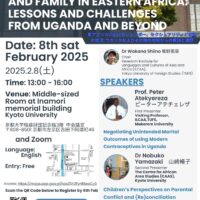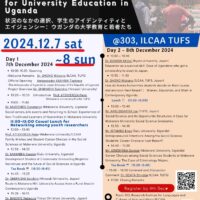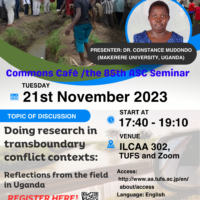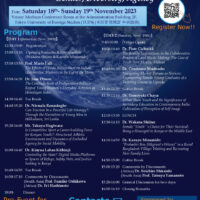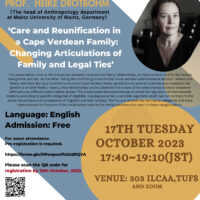2022年度第4回研究会(通算第8回目)2022年12月3日(土)13:00–16:30
1.近藤有希子(AA研共同研究員、京都大学)
「『もう丘には戻らない』―虐殺後のルワンダに生きる若者の選択と暴力の記憶―」
2.セーラ ジョージア(AA研共同研究員、京都大学)
「やせっぽちの女の子、太った女性:ウガンダ都市部における肥満のダイナミクス」
The 8th meeting of the ILCAA-Africa youths’ project on Saturday 3rd December 2022, Presenter: SEERA Georgina
Title: Skinny girls, fat women: the dynamics of obesity among women in urban Uganda
Abstract of the presentation
Introduction: Obesity among women tends to be more prevalent among the older women than among the younger women in Uganda and in most countries around the world. The biological circumstances surrounding this are undeniable. However, since there are exceptions, it is worth exploring the circumstances that characterize the co-existence of skinny girls and fat women in society, with sometimes even the same skinny girl, growing up into a fat or very fat woman. Furthermore, although it is reasonably-known that young people in Africa, particularly those living in urban areas must use their brains to survive the harsh economic environment and end up engaging in a large variety of possible livelihood activities, no study to our knowledge has ventured to elucidate the myriad of existent livelihood activities or their characteristics.
Objective: To elucidate characteristics of the myriad of livelihood activities that are engaged in by young people in Uganda and their relationship to the observed higher prevalence of obesity among the older women than among the younger women living in urban Uganda.
Methods: Several women living in a rural area (N=743) and those living in an urban area (N=1042) of Central Uganda were interviewed about their main livelihood activities and those of their husbands (N=292). Additionally, five mother-daughter pairs of women were interviewed and observed with a focus on their food and activity habits, for a week at a time, between February and March 2019, and June and July 2019—two weeks per person in total.
Results: There were up to 100 possible livelihood activities that were elicited—rural women– 19, urban women–58, and urban men–58. Besides farming which was a main livelihood activity only in the rural area, many of the livelihood activities of both the women and men, were distinctly sedentary—low energy-demanding. When at home living together with their mothers and other family members, daughters tended to do more work, expending more energy through activity, and eat less, intaking less energy from food, than the mothers. However, when the daughters worked in sedentary livelihood activities, they tended to eat more, intaking more energy from food which they acquired it from restaurants and were less active, expending less energy in activity by working long hours in sedentary livelihood activities and spending long hours commuting by public transportation. However, when daughters were married with young children, and living alone/with their husbands, they tended to eat less, intaking less energy from food and expend more energy in activity, through household chores. On the other hand, even when daughters had young children, but were living in a household with many other people and/or engaged in sedentary livelihood activities, their energy intake from food which they acquired in restaurants, was still high and their energy expenditure from activity was still low.
Conclusion: Women are more likely to remain small when the housework burden predominantly falls on them, if they engage in energy-demanding livelihood activities i.e., farming for rural women and men but not in the urban, and when they eat home-cooked food. When they can afford to delegate the housework burden, engage in sedentary livelihood activities, and/or to eat outside the home, women expend less energy through activity and intake more energy from food, and thus are more likely to increase in body size. The ability to delegate household chores, engage in sedentary livelihood activities, and eat purchased food tends to occur later in the lives of women as they grow from girls to women. This explains, at least in part, why older women tend to be more likely to be obese than younger women in urban Uganda. Urban women could thus benefit from continued participation in the daily household chores, engaging in more voluntary physical activity to increase their metabolism as they grow older, and eating more home-cooked meals even as their ability to afford purchasing alreadycooked food increases, to reduce their propensity towards increasing body size and obesity.
“Never Do We Return to the Hill”: The Army as Young Women’s Future in Contemporary Rwanda
Yukiko Kondo (Kyoto University)
This presentation clarifies how young women in contemporary rural Rwandan society look towards their future and seek it, while making social adjustments within their communities. In particular, the choices made by the women who volunteered for the military, and the resulting hesitations and conflicts, are depicted as events occurring at the intersection of ethnicity and gender differences, as well as the nature of the contemporary “youth.”
The choice to volunteer for the army tends to be made for financial remuneration and the possibilities that come with it. It provides respite from living in rural areas where employment is scarce. This became possible in the context of the growing militarization of society that accompanied the need to maintain order in post-genocide Rwanda. In addition, the Rwandan military today is positioned as an entity that transcends gender and ethnic differences.
However, the choice of women to join the military is sometimes accompanied by rejection as well as acceptance by their families and friends. Sometimes their choice is respected as “a job to protect the country,” while sometimes, it is opposed by those in their community who say, “she is a girl.” The women also respond cautiously to the gazes of their romantic partners, and here we can see the struggles of women in present day Rwanda. They want to be identified as a “submissive woman” but also “an attractive woman with the ability to earn money.”
Their choice to volunteer for the army, supported by their multilayered thoughts, reflects contemporary Rwandan society. It is shared with those closest to them, by adjusting their narratives according to their partners, which is sometimes accepted and sometimes opposed, but all of this culminates in a future for these women.
「『もう丘には戻らない』:現代ルワンダにおける若い女性の未来としての軍隊」
近藤有希子(京都大学)
本発表では、現代のルワンダ農村社会を生きる未婚の女性たちが、自身の未来をいかに見据えており、また親密な者とのあいだでどのような調整をおこないながら、それを模索するのかを明らかにした。とくに軍隊へ志願した彼女たちの選択とそれに伴う逡巡や葛藤が、現代の「若者」という世代のあり方とともに、エスニシティやジェンダーの差異が交差する地点で生じている出来事であることを描き出す。
軍隊への志願という選択は、土地も雇用も存在しない農村部に留まることを拒否して、まとまった現金とそれに伴う可能性を得るためになされる傾向にあった。そしてそれは、虐殺後のルワンダにおいて国の秩序を維持するためことに伴う、社会の軍事化の進展のなかでこそ可能となっていた。加えて現在のルワンダの軍隊は、ジェンダーやエスニシティの差異を乗り越えた存在として位置づけられている。
しかし女性たちの軍隊という選択には、ときに家族や恋人などの親しい者たちからの、理解だけでなく拒絶をも伴う。「国を守る仕事」としてその選択が尊重されることもあれば、「女の子なのに」と地域の多数が反対することもある。また、彼女たちは恋人からのまなざしにも慎重に応じており、そこには「従順な女性」であり続けることや、他方で「稼ぐ能力のある魅力的な女性」になることなどの、現在のルワンダで女性として生きることへの葛藤が垣間見える。
多層の想いに支えられた軍隊への志願という彼女たちの選択は、現代のルワンダ社会を反映させつつ、親しい者たちとのあいだで相手に応じて語りを調整しながら共有され、ときに配慮されたり反対されたりするなかで、彼女たちの未来として結実していくものである。
 en_US
en_US ja
ja